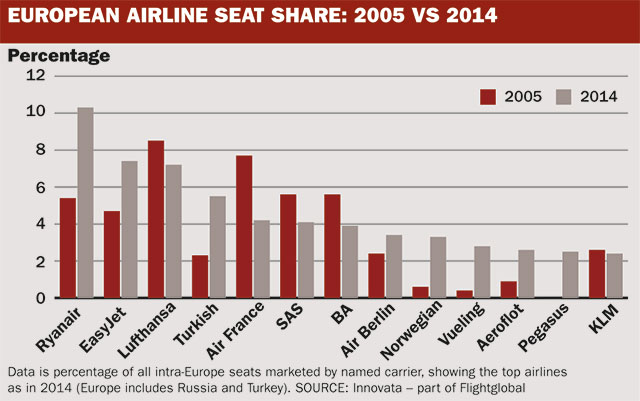The dawn of the new millennium saw the beginnings of a European aviation market revolution driven by deregulation, but the last decade has seen the compounding of a new order.
That is the view of Peter Morris, chief economist at Flightglobal's Ascend consultancy, in a paper he is presenting at the Aviation Leadership Summit organised by the Association of European Airlines and hosted by Turkish Airlines in Istanbul. His analysis of the European networks over the period 2005-2014 using schedules data from Flightglobal's Innovata arm reveals the massive structural and operator changes that have occurred.
Morris says that if the changes have one thing in common, it is to emphasise the ultimate long-term power of the air traveller's choice, which has been dented only slightly by the stumbling market intervention of various governments.
"The market changes identified through the Innovata data start with a 60% rise in connections between airport pairs across Europe. The capacity balance between airlines has changed remarkably," says Morris. "Available routes have risen from around 5,400 city pairs in 2005 to 8,000 in 2014. The changes have not been only in one direction. A further 5,000 route pairs which were connected at some point between 2005 and 2014 are not now flown, emphasising the dynamic nature of the marketplace."

The data reveals that the number of operating carriers (with more than 100 flights a year) has fallen from 240 to 179, but Morris argues that those remaining will be better suited to deliver future growth.
"Clearly the number of airlines does not suggest any great issue on the competition front. Interestingly some 70% of airport pairs are connected by only one carrier – roughly the same proportion as in 2005," he says. "However, one feature of the network development has been the element of flexibility by some customers, particularly for 'new wave' airlines, to use alternate airports and routes."
Morris sees the shape of Europe's future network being partly driven by government strategies, as well as by the ongoing diversification of routes, with Turkey, Russia and Eastern Europe connections growing.
"Majors may struggle to maintain frequency to their hubs and rely more on regional subsidiaries or on fine-tuning the aircraft types. The effects of the revolution now become evolution, and will continue indefinitely," he says.
Source: Flight Daily News
















